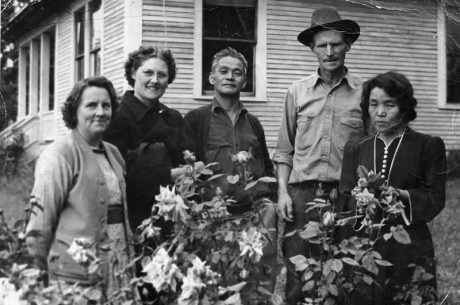When We Said Farewell To Our Own
Posted February 1, 2017 at 5:50 am by Tim Dustrude

Left to right: Edna Nash, Beryl Wade, Jack Saoka, John Nash, and Yuki Saoka – SJ Historical Museum photo
This is the February edition of the history column by the San Juan Historical Museum…
This month marks the 75th anniversary of President Roosevelt’s Executive Order 9066, which he signed on February 19, 1942. In response to the World War II bombing of Pearl Harbor by Japan, it authorized the forced evacuation and relocation of persons of Japanese ancestry. It was expulsion and imprisonment. Nearly 13,000 adults and children from Washington State and 110,000 from the U.S. West Coast were imprisoned. Two thirds were U.S. citizens.
On San Juan Island, two local couples were ordered to be relocated. Hajime and Yoshi Uyetsuka were imprisoned at the Tule Lake Relocation Center in California while Jack and Yuki Saoka were sent to Camp Minidoka in Idaho. They were allowed to bring only what they could carry.
It is the Saokas we know the most about. Jack was born in Japan in 1888 as Koheiji Saoka. He had lived on San Juan Island for 25 years, ever since 1917 when he arrived with his wife Fuji and their young daughter Fumiko.
Sadly, Fuji died from influenza in the 1920 epidemic. Jack worked his way up from cannery worker to supervisor and eventually established his own florist shop and nursery. Jack and his second wife Yuki raised his daughter Fumiko, who graduated from Friday Harbor High School in 1933. She would later move to Seattle and marry George Kambe. Fumiko, George, and their infant daughter Carolyn were also sent to Camp Minidoka. While they were there, another child was born to them.
Jack and Yuki Saoka were imprisoned for 2 years, 8 months and 6 days. After their release from Camp Minidoka, the Saokas did not resume their lives here on the island, although they, along with Jack’s first wife Fuji, now rest eternally in Madden Lane’s Protestant cemetery.
Pictured in August, 1942 on the evening before the Saokas departed San Juan Island (left to right): Edna Nash, Beryl Wade, Jack Saoka, John Nash, and Yuki Saoka. This photo also appears in Mike and Julia Vouri’s book, Images of America: San Juan Island, which can be purchased at the San Juan Historical Museum. To read more about Executive Order 9066 and this time in our country’s history, visit History Link, Washington’s online encyclopedia, at www.historylink.org.
You can support the San Juan Update by doing business with our loyal advertisers, and by making a one-time contribution or a recurring donation.
Categories: Government, History
6 comments:










6 comments...
Thank you for printing this photo of my Uncle John and his wife Edna (wishing she didn’t look so chipper on such an occasion as the one pictured).
And thanks to Tim for posting it.
It is particularly poignant at this time in our national history.
My grandparents, John and Edna Nash, stored the Saoka’s belongings both during their internment and then for many years after in the hopes of their return. The Saokas were friends of my grandparents and were deeply missed.
It was wrong then, and it is wrong now. I have never seen this picture of my grandparents, and I didn’t know about their friends.
That look on my grandma’s face looks like a nervous smile to me.
John and Edna were my grandparents. When I was a kid, I remember being told that they kept the Saokas’ dog, and that it was poisoned. I sure wish I had thought to ask Grandma more about them.
Such a great article. I wish every community would post remembrances of the people who lived in them who were so persecuted. They should never be forgotten. Thanks.
On behalf of the San Juan Historical Society & Museum, thank you to all for your comments on this photo and story. They all become important parts of our island story and will be saved. It’s not only about a sad time in our history, but also about the heart of our community.
By submitting a comment you grant the San Juan Update a perpetual license to reproduce your words and name/web site in attribution. Inappropriate, irrelevant and contentious comments may not be published at an admin's discretion. Your email is used for verification purposes only, it will never be shared.